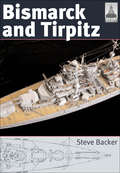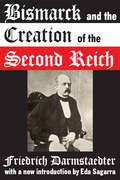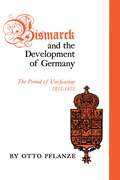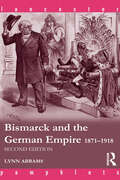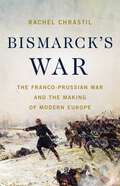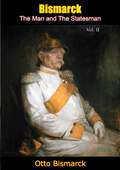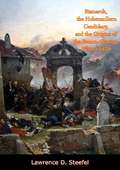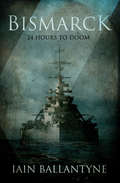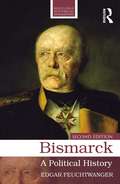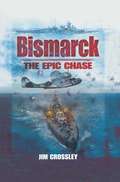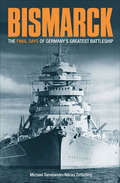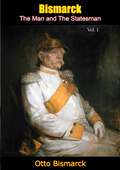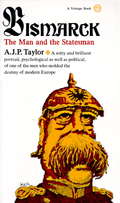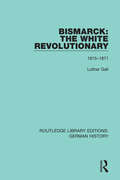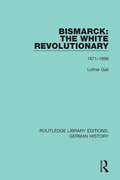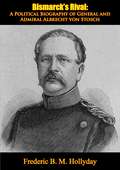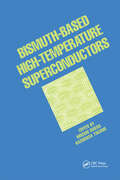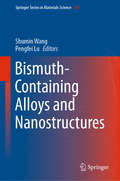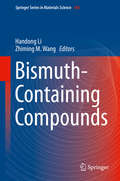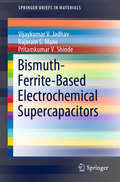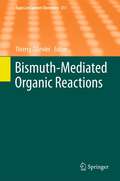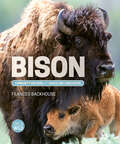- Table View
- List View
Bismarck and Tirpitz: Bismarck And Tirpitz (Shipcraft Ser. #Vol. 10)
by Steve BackerA treasury of useful facts, plans, and photos for modelers. The ShipCraft series provides in-depth information about building and modifying model kits of famous warship types. Lavishly illustrated, each book takes the modeler through a brief history of the subject class, highlighting differences between sister-ships and changes in their appearance over their careers. This includes paint schemes and camouflage, featuring color profiles and highly detailed line drawings and scale plans. The modeling section reviews the strengths and weaknesses of available kits, lists commercial accessory sets for super-detailing of the ships, and provides hints on modifying and improving the basic kit. This is followed by an extensive photographic gallery of selected high-quality models in a variety of scales, and the book concludes with a section on research references—books, monographs, large-scale plans, and relevant websites. This volume covers the famous German sister-ships whose fates were so very different—Bismarck had a short but glorious career, first sinking HMS Hood and then in turn being sunk by the Home Fleet, whereas the Tirpitz spent most of the war skulking in Norwegian fjords, fending off attacks by midget submarines and carrier aircraft before being finally sunk by enormous, specially designed bombs dropped by RAF Lancasters.
Bismarck and the Creation of the Second Reich
by Friedrich DarmstaedterChancellor Otto Bismarck's "greatness" lay in what he created, the German Reich of 1871. This Reich was the product of his genius, and in it his genius took complete shape. In less than a decade German chaos was brought to an end and in its place a homogeneous state began to arise. The structure of this state left no room for opposing political forces, but rather made ready a roof under which these forces might rally, support each other, and gain strength. Bismarck and the Creation of the Second Reich begins as a biography but continues as a description of his political life and the ideas that led to the birth of an authoritarian political culture.The community from which Bismarck formed his conception of the state was first the family and clan, then the landlord caste, and finally the people. These communities found their unifying force in the Kaiser, who as their patriarchal head enjoyed divine honors as ruler by the grace of God. The existence of the state was justified as the framework within which these communities existed, and it had thus a biological as well as a religious content. This idea of the state as the supreme moral command of religion was too powerful a driving force to be dropped in favor of the rational view of the state as a potential war machine. Bismarck reconciled the two concepts by use of the concept of a "people in arms," an idea which had originated in German history as a means of defense, but which was changed into one of aggression. In order to become a means of aggression it was changed into a moral precept commanded by religion, and indeed into the supreme precept.Through the unfolding of the political life of Bismarck, we find the roots of the Nazi Third Reich--the inability of the people to educate themselves about politics enough to effect any change or satisfy their own political needs. In this loss of control, the authoritarian regime grew stronger. Though Bismarck's work led to the creation and implementation of the Second Reich, "it is in the Third Reich that we find the devilish distortion that was its fruit." This volume is an essential tool for understanding twentieth-century German history.
Bismarck and the Development of Germany: The Period of Unification, 1815-1871 (Princeton Legacy Library #1087)
by Otto PflanzeThis political history of Germany assesses Bismarck's role in the events which paved the way for the catastrophes of the twentieth century, showing how Bismarck first established the association between German nationalism, Prussian militarism, and Hohenzollern authoritarianism. The author is completing a second volume, "The Period of Consolidation, 1871-1890." Volume I has been awarded the McKnight Foundation Humanities Award.
Bismarck and the German Empire: 1871–1918 (Lancaster Pamphlets)
by Lynn AbramsUpdated and expanded, this second edition of Bismarck and the German Empire, 1871–1918 is an accessible introduction to this important period in German history. Providing both a narrative of events at the time and an analysis of social and cultural developments across the period, Lynn Abrams examines the political, economic and social structures of the Empire. Including the latest research, the book also covers: how Bismarck consolidated his regime the Wilhelmian period the factors that led to the outbreak of World War One. With a new introduction and updated further reading section – including a guide to useful websites – this book gives students the ideal introduction to this key period of German history.
Bismarck's War: The Franco-Prussian War and the Making of Modern Europe
by Rachel Chrastil"The best modern account" (Wall Street Journal) of the war that toppled the French Empire, unified Germany, and set Europe on the path to World War I Among the conflicts that convulsed Europe during the nineteenth century, none was more startling and consequential than the Franco-Prussian War of 1870–1871. Deliberately engineered by Prussian chancellor Otto von Bismarck, the war succeeded in shattering French supremacy, deposing Napoleon III, and uniting a new German Empire. But it also produced brutal military innovations and a precarious new imbalance of power that together set the stage for the devastating world wars of the next century. In Bismarck&’s War, historian Rachel Chrastil chronicles events on the battlefield in full, while also showing in intimate detail how the war reshaped and blurred the boundaries between civilian and soldier as the fighting swept across France. The result is the definitive history of a transformative conflict that changed Europe, and the history of warfare, forever.
Bismarck, The Man and The Statesman Vol. II (Bismarck: The Man and The Statesman #2)
by Otto Bismarck"Politics is the art of the possible," Otto Von Bismarck famously said, and here, in his own words, the art of politics is laid bare by one of the most prominent and influential European statesmen of the nineteenth century. These are the intimate reflections and reminiscences of the man who unified the independent Germanic states into one nation, and whose subsequent promotion of the new country's colonial ambitions earned him the title of the founder of the German empire. This first volume of what must be considered an essential historical document details Bismarck's early life, from the political views of his youth and his entrance into public life through his work in government ministries and his time at the Court of Munich. It is vital reading for any informed, in-depth understanding of modern European history.-Print ed.
Bismarck, the Hohenzollern Candidacy, and the Origins of the Franco-German War of 1870
by Lawrence D. SteefelIt is known that the plan to elect a Prussian prince to the Spanish throne was the proximate, and Bismarck’s “Ems telegram” an immediate cause of the war of 1870. But much has remained obscure about the roles of the principal figures. Lawrence Steefel fills in the lacunae with secret German documents available only after World War II, including the correspondence between Bismarck and Marshal Prim of Spain. It becomes clear that Bismarck did not initiate the Hohenzollern candidacy and that one of his most important reasons for adopting it was his fear of an anti-Prussian coalition of Catholic powers.
Bismarck: 24 Hours to Doom
by Iain BallantyneWith extensive eyewitness accounts, the author of Killing the Bismarck vividly reconstructs the day British soldiers sank the infamous Nazi battleship. May 26, 1941. After a desperate chase lasting three days and more than seventeen hundred miles, Britain’s Home Fleet would finally close in on the world’s most powerful battleship, the very ship that sank the Royal Navy’s battlecruiser HMS Hood. The German battleship Bismarck was literally in a class by itself, being one of two newly-designed Bismarck-class ships in the German fleet. But it would soon face, and ultimately lose, a brutal fight to the finish involving more than five thousand men of the Royal Navy and twenty-six thousand men of Hitler’s Kriegsmarine. Historian Iain Ballantyne spent years conducting interviews with surviving veterans who had been present on that fateful day. Published here for the first time, alongside a compelling narrative of the final twenty-four hours of the mission to sink the Bismarck, are transcripts of those interviews, offering the unique eyewitness accounts of Royal Navy sailors who participated in one of the most significant sea battles of World War II.
Bismarck: A Political History (Routledge Historical Biographies)
by Edgar FeuchtwangerBismarck was arguably the most important figure in nineteenth-century European history after 1815. In this biography, Edgar Feuchtwanger reassesses Bismarck's significance as a historical figure. He traces his development from a typical Junker, a reactionary and conservative, into the so-called white revolutionary who recast European affairs more drastically than anyone since Napoleon. This second edition includes a new introduction, taking into account the most recent scholarship on Bismarck, which reflects on Bismarck's legacy in modern Germany, which is once again the European economic powerhouse for which Bismarck laid the foundations. Feuchtwanger's lucid account demythologizes the German leader without demonising him. This book leaves the reader with a strongly-etched portrait of one of the decisive makers of the modern world.
Bismarck: The Epic Chase
by Jim CrossleyWhen the German Battleship Bismarck was commissioned in 1940 she was one of the fastest and most powerful ships afloat. To the Royal Navy and the security of Allied shipping in the Atlantic she posed an enormous threat she must be destroyed. When she broke out into the Atlantic in 1941, some of Britains most powerful ships were sent to pursue and sink her. The first encounter proved disastrous for the British Battleship HMS Hood, which was sunk at 0800 on 24 May. Bismarck had sustained several hits from HMS Prince of Wales but the Royal Navy were unsure of the extent of the damage and whether she would attempt to return to Germany for major repairs or sail for France to lick her wounds. Previous written accounts suggest that the whereabouts and course of Bismarck were unknown to the Allies until discovered by an RAF Catalina at 1030 on 26 May. This was followed an hour later by the arrival of a Fairey Swordfish flying off HMS Ark Royal. This aircraft hit the Bismarck with her torpedo and severely damaged her steering gear. It was now only a matter of time before the full firepower of the British capital ships would close in and destroy Germanys greatest ship.This new book revises previous theory of the events, in which earlier publications have failed to reveal the full extent of the capabilities of both British and German Radar or the significance of British ULTRA signal intercepts.
Bismarck: The Final Days of Germany's Greatest Battleship
by Niklas Zetterling Michael TamelanderThe author of Blitzkrieg covers one of the most dramatic events of the Second World War in an &“outstanding book about naval warfare&” (World War II History). When the German battleship Bismarck—a masterpiece of engineering, well-armored with a main artillery of eight 15-inch guns—left the port of Gotenhafen for her first operation on the night of May 18, 1941, the British battlecruiser Hood and the new battleship Prince of Wales were ordered to find her quickly, as several large convoys were heading for Britain. On May 24, Bismarck was found off the coast of Greenland, but the ensuing battle was disastrous for the British. The Hood was totally destroyed within minutes, with only three crewmen surviving, and Prince of Wales was badly damaged. The chase resumed until the German behemoth was finally caught, this time by four British capital ships supported by torpedo-bombers from the carrier Ark Royal. The icy North Atlantic roiled from the crash of shellfire and bursting explosions until finally the Bismarck collapsed, sending nearly two thousand German sailors to a watery grave. Tamelander and Zetterling&’s work rests on stories from survivors and the latest historical discoveries. The book starts with a thorough account of maritime developments from 1871 up to the era of the giant battleship, and ends with a vivid account, hour by hour, of the dramatic and fateful hunt for the mighty Bismarck, Nazi Germany&’s last hope to pose a powerful surface threat to Allied convoys. &“Exciting story-telling . . . recreat[es] the thrill of the hunt.&” —International Journal of Maritime History &“[An] epic sea chase and its vivid, human details.&” —World War II
Bismarck: The Man and The Statesman Vol. I (Bismarck: The Man and The Statesman #1)
by Otto Bismarck"Politics is the art of the possible," Otto Von Bismarck famously said, and here, in his own words, the art of politics is laid bare by one of the most prominent and influential European statesmen of the nineteenth century. These are the intimate reflections and reminiscences of the man who unified the independent Germanic states into one nation, and whose subsequent promotion of the new country's colonial ambitions earned him the title of the founder of the German empire. This first volume of what must be considered an essential historical document details Bismarck's early life, from the political views of his youth and his entrance into public life through his work in government ministries and his time at the Court of Munich. It is vital reading for any informed, in-depth understanding of modern European history.-Print ed.
Bismarck: The Man and the Statesman (Penguin Classic Biography Ser.)
by A. J. P. TaylorA re-evaluation of Bismarck's motives and methods, focusing on the chancellor's rise to power in the 1860's and his removal from office in 1890.
Bismarck: Volume 1 1815-1871 (Routledge Library Editions: German History #14)
by Lothar GallOriginally published in English in 1986, these volumes are far more than the story of the life of a powerful statesman. The name Bismarck sums up the entire political, social, economic and intellectual development of central Europe in the second half of the 19th Century and the internal and external shape that Germany then assumed. These books analyse how much of this was Bismarck’s personal achievement or whether he was the man who put the nation on the disastrously wrong course that reached its fateful culmination in 1933? They examine whether Bismarck’s success was precisely because he implemented policies for which the time was ripe and did so in ways that were in harmony with the historical evolution of central Europe.
Bismarck: Volume 2 1871 - 1898 (Routledge Library Editions: German History #15)
by Lothar GallOriginally published in English in 1986, these volumes are far more than the story of the life of a powerful statesman. The name Bismarck sums up the entire political, social, economic and intellectual development of central Europe in the second half of the 19th Century and the internal and external shape that Germany then assumed. This book analyses how much of this was Bismarck’s personal achievement or whether he was the man who put the nation on the disastrously wrong course that reached its fateful culmination in 1933? It examines whether Bismarck’s success was precisely because he implemented policies for which the time was ripe and did so in ways that were in harmony with the historical evolution of central Europe.
Bismarck’s Rival: A Political Biography of General and Admiral Albrecht von Stosch
by Frederic B. M. HollydayOriginally published in 1960, “[t]he political biography of Albrecht von Stosch (1818-1896), a prominent man of action, opens unique insights into the entire Bismarckian epoch. Stosch became a general, an admiral, and a minister of state. As Chief of the Admiralty he was the founder of the Imperial German Navy. He was also a member of the Prussian Chamber of Peers and of the Bundesrat, and he spoke in the Reichstag. His friendship with members of the royal family, the armed forces, the bureaucracy, and his close ties with journalists, members of the Reichstag and Bundesrat, and other leaders of public opinion gave him unusual opportunities to observe the German military and political system at work. His opportunities for observation, combined with a talent for expression and an objective temper of mind, make his published volume of memoirs one of the chief sources of the history of the German Wars of Unification. Paul Matter and Sir Charles G. Robertson, major biographers of Bismarck, regretted that the volume ends with the year 1871. The present study relies in part on the unpublished manuscripts in which Stosch carried the story into the 1890’s. […]“In presenting the political life of Stosch, I have chosen to recount the events of his career and the development of his opinions at some length. It seems to me that truth in modern German history has suffered from the attempts of doctrinaire theorists to cut events and personalities to their own patterns and that what is needed is biographies and monographs which present more elaborate descriptions and more subtle and complex explanations of men and their actions than do books which drive a thesis. Also, it is hoped that to the general historian narrative and descriptive I detail in a specialized account will be more useful than a bare statement.”
Bismillah, Let's Eat!: Fresh and Vibrant Recipes from my Family to Yours
by Zehra AllibhaiWelcome to Zehra&’s kitchen, where good food, family, and nutrition meet! Muslims from all around the world start each meal by saying "Bismillah" which means &“I begin in the name of God&”. Similar to the practice of saying grace before you eat, it is like a short practice of gratitude. In her first cookbook, beloved Toronto-based hijabi fitness influencer and coach Zehra Allibhai welcomes everyone to her table, sharing a new way to think about family food. Zehra&’s own cooking evolution started in the kitchen with her Indian Kenyan family, expanded through culinary adventures with her husband, and grew again as a mother and fitness influencer. Her style of cooking is flavorful, accessible, wholesome–and above all–meant to be shared with joy. From her healthy spin on traditional dishes such as shakshuka and chaat to sumac chicken and lamb karahi, her renowned hearty salads, and treats such as the perfect one-bowl chocolate cake, Zehra makes being in the kitchen fun, easy—and incredibly delicious! With more than 130 recipes for every meal, and a healthy Ramadan guide for those who observe, Bismillah is a go-to for everyday dishes to satisfy the whole family.
Bismuth-Based High-Temperature Superconductors (Applied Physics)
by Hiroshi Maeda Kazumasa ToganoProvides coverage of the ongoing investigations on bismuth-based high-temperature cuprate superconductors, integrating scattered research activities and literature from 70 leading scientists throughout the world. The text covers crystal structures and microstructures, reversible or equilibrium magnetic and thermal properties, atomic site tunnel spe
Bismuth-Containing Alloys and Nanostructures (Springer Series in Materials Science #285)
by Shumin Wang Pengfei LuThis book focuses on novel bismuth-containing alloys and nanostructures, covering a wide range of materials from semiconductors, topological insulators, silica optical fibers and to multiferroic materials. It provides a timely overview of bismuth alloys and nanostructures, from material synthesis and physical properties to device applications and also includes the latest research findings. Bismuth is considered to be a sustainable and environmentally friendly element, and has received increasing attention in a variety of innovative research areas in recent years. The book is intended as a reference resource and textbook for graduate students and researchers working in these fields.
Bismuth-Containing Compounds (Springer Series in Materials Science #186)
by Zhiming M. Wang Handong LiBismuth-containing compounds comprise a relatively unexplored materials system that is expected to offer many unique and desirable optoelectronic, thermoelectric, and electronic properties for innovative device applications. This book serves as a platform for knowledge sharing and dissemination of the latest advances in novel areas of bismuth-containing compounds for materials and devices, and provides a comprehensive introduction to those new to this growing field. Coverage of bismides includes theoretical considerations, epitaxial growth, characterization, and materials properties (optical, electrical, and structural). In addition to the well-studied area of highly mismatched Bi-alloys, the book covers emerging topics such as topological insulators and ferroelectric materials. Built upon fundamental science, the book is intended to stimulate interest in developing new classes of semiconductor and thermoelectric materials that exploit the properties of Bismuth. Application areas for bismide materials include laser diodes for optical communications, DVD systems, light-emitting diodes, solar cells, transistors, quantum well lasers, and spintronic devices.
Bismuth-Ferrite-Based Electrochemical Supercapacitors (SpringerBriefs in Materials)
by Vijaykumar V. Jadhav Rajaram S. Mane Pritamkumar V. ShindeThis book provides a much-needed, up-to-date overview of unary, binary and ternary bismuth-ferrite-based systems, with a focus on their properties, synthesis methods and applications as electrochemical supercapacitors. It introduces readers to the basic structure and properties of ferrites in general, focusing on the selection criteria for ferrite materials for electrochemical energy storage applications. Along with coverage of ferrite synthesis methods, it discusses bismuth-ferrite structures in unary, binary and mixed ferrite nanostructure systems, as well as future perspectives and limitations for using ferrites as electrochemical supercapacitors. A valuable resource for beginners and advanced researchers working on similar topics, this book enables them to understand the core materials and electrochemical concepts behind bismuth-ferrite-based systems as energy storage materials.
Bismuth-Mediated Organic Reactions (Topics in Current Chemistry #311)
by Thierry OllevierBismuth Catalysts in Aqueous Media, by Shū Kobayashi, Masaharu Ueno and Taku Kitanosono.- Pentavalent Organobismuth Reagents in Organic Synthesis: Alkylation, Alcohol Oxidation and Cationic Photopolymerization , by Yoshihiro Matano.- Environmentally Friendly Organic Synthesis Using Bismuth(III) Compounds, by Scott W. Krabbe and Ram S. Mohan.- Bismuth-Catalyzed Addition of Silyl Nucleophiles to Carbonyl Compounds and Imines, by Thierry Ollevier.- Bismuth Salts in Catalytic Alkylation Reactions, by Magnus Rueping and Boris J. Nachtsheim.- New Applications for Bismuth(III) Salts in Organic Synthesis: From Bulk Chemicals to Steroid and Terpene Chemistry, by J. A. R. Salvador, S. M. Silvestre, R. M. A. Pinto, R. C. Santos and C. Le Roux.- Cationic Bismuth-Catalyzed Hydroamination and Direct Substitution of the Hydroxy Group in Alcohols with Amides, by Shigeki Matsunaga and Masakatsu Shibasaki.- Transition-Metal Catalyzed C-C Bond Formation Using Organobismuth Compounds, by Shigeru Shimada and Maddali L. N. Rao.- Bismuth(III) Salts as Synthetic Tools in Organic Transformations, by J. S. Yadav, Aneesh Antony and Basi V. Subba Reddy.
Bison (Nature's Children)
by Amy-Jane BeerDescribes the physical features, habits and habitat of the American Bison sometimes called a Buffalo
Bison: Community Builders and Grassland Caretakers (Orca Wild)
by Frances BackhouseBison are North America’s largest land animals. Some 170,000 wood bison once roamed northern regions, while at least 30 million plains bison trekked across the rest of the continent. Almost driven to extinction in the 1800s by decades of slaughter and hunting, this ecological and cultural keystone species supports biodiversity and strengthens the ecosystems around it. Bison: Community Builders and Grassland Caretakers celebrates the traditions and teachings of Indigenous Peoples and looks at how bison lovers of all backgrounds came together to save these iconic animals. Learn about the places where bison are regaining a hoof-hold and meet some of the young people who are welcoming bison back home. The epub edition of this title is fully accessible. Praise for Frances Backhouse: ★"An important book for helping kids see past the sterotypes of terrifying grizzly bears and join the call for conservation."—School Library Journal, starred review for Grizzly Bears "The impressively comprehensive text is chatty and entertaining...This illuminating avian introduction is sure to make an owl out of anyone."—Booklist, review for Owls "An engaging book that will leave readers spouting facts about beavers. Students will have a new appreciation for these innovative builders and their significant impact on the landscape and ecosystems of North America."—School Library Journal, review for Beavers
Bispecific Antibodies
by Roland E. KontermannThe concept of using bispecific antibodies for cancer therapy by retargeting immune effector cells was developed several years ago. Initial clinical studies were rather disappointing mainly due to low efficacy, severe side effects and the immunogenicity of the bispecific antibodies. The progress in antibody engineering finally led to the generation of new classes of bispecific antibodies lacking these obstacles. In addition, new applications were established, such as pre-targeting strategies in radioimmunotherapy and dual targeting approaches in order to improve binding, selectivity and efficacy. In this book, the different ways of generating bispecific antibodies are described, with emphasis on recombinant formats. The various applications of bispecific antibodies, e.g. in cellular cancer immunotherapy, radioimmunotherapy and pretargeting strategies are covered, and emerging applications such as dual targeting strategies, which involve the simultaneous inhibition of two targets, are addressed.
